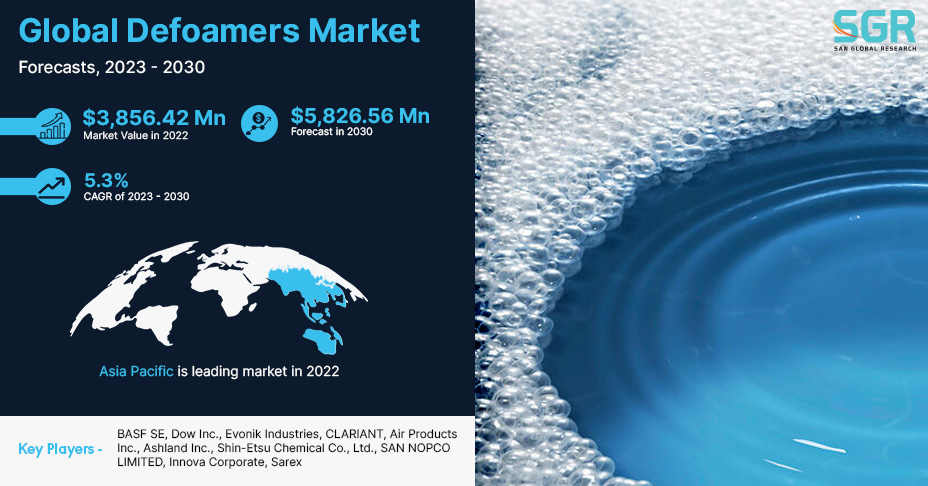The Role of Defoamers in Enhancing Item High Quality and Performance
In various making processes, the presence of foam can substantially impede product top quality and operational efficiency. Defoamers work as vital additives that reduce this problem, ensuring smoother manufacturing operations while boosting the useful and aesthetic characteristics of the last items (defoamers). Their application extends a wide variety of industries, from food and drink to drugs, where uniformity and reliability are paramount. However, the selection of the suitable defoamer can be vital to achieving optimum outcomes, raising essential inquiries about formula compatibility and efficiency metrics that merit additional exploration.
Understanding Defoamers
Comprehending the function of defoamers is essential for preserving item quality across numerous markets. Defoamers are chemical additives designed to avoid the formation and lower of foam in fluid systems, which can negatively influence procedures such as mixing, loading, and surface area tension. Frothing can cause ineffectiveness, product problems, and endangered visual allure, making defoamers a vital element in manufacturing operations.
In industrial applications, defoamers aid to boost item uniformity and stability. The efficient use of defoamers not only guarantees smoother production processes however additionally contributes to superior item efficiency.
Additionally, the choice and formulation of a defoamer must straighten with details application demands, such as compatibility with various other components, efficiency under differing temperature and pH problems, and prospective regulative restraints. Inevitably, recognizing defoamers' features and their importance in numerous solutions is critical for maximizing production and ensuring the best quality end items.
Kinds of Defoamers
Defoamers can be classified into numerous types based upon their make-up and device of activity. The main types consist of silicone-based, non-silicone organic, and inorganic defoamers.
Silicone-based defoamers are amongst the most reliable, mainly as a result of their capacity to spread out rapidly on the liquid surface area and interrupt foam development. Their special chemical structure permits for exceptional stability, making them appropriate for high-temperature applications and settings with differing pH degrees.
Non-silicone organic defoamers, typically composed of natural oils or fats, are valued for their biodegradability and reduced poisoning. These are generally utilized in food and drink applications where safety and security and environmental effect are vital.
Not natural defoamers, which consist of materials like talc or calcium carbonate, act by raising the thickness of the fluid, therefore minimizing foam stability. They are typically made use of in industrial processes where compatibility with various other products is not a problem.
Each kind of defoamer has distinctive benefits and limitations, enabling customized remedies relying on the certain lathering issues encountered in numerous applications. Recognizing these differences is essential for optimizing performance and achieving desired item quality.
Applications Across Industries
Various industries leverage defoamers to boost product high quality and functional effectiveness. In the food and beverage market, defoamers are vital in processes such as developing and dairy products production to stop foam development, which can cause inefficiencies and item disparity. By regulating foam, makers can guarantee far better yield and an extra uniform item.
In the pharmaceutical industry, defoamers play a crucial role in the formula of liquid medicines, where too much foam can hinder blending and accurate dosing. Their usage helps maintain the integrity of the formulas and promotes smoother production procedures.
The paint and coverings market additionally counts on defoamers to boost the performance of products throughout application. By decreasing foam, these additives make certain a smoother finish and improve the aesthetic qualities of the end product.

Advantages of Making Use Of Defoamers
While the application of defoamers differs throughout sectors, their benefits regularly boost item quality and process efficiency. One considerable advantage is the reduction of foam development throughout producing processes, which can otherwise bring about manufacturing delays and disparities in product top quality. By decreasing Clicking Here foam, defoamers make it possible for a smoother circulation of materials, helping with more reliable procedures and lowering the chance of tools malfunctions.
Additionally, using defoamers can enhance the appearance and appearance of end products. In fields such as finishes, paints, and food processing, too much foam can jeopardize the visual appearances and general top quality, while the appropriate defoamer application makes certain an uniform finish and preferable characteristics. In addition, defoamers can contribute to set you back savings by decreasing waste during manufacturing and enhancing the usage of resources (defoamers).

Selecting the Right Defoamer
Selecting the right defoamer is important for enhancing production processes and guaranteeing product high quality. The selection of defoamer influences not only the effectiveness of foam control but also the overall efficiency features of the last product. Elements to consider consist of the kind of application, the chemistry of the solution, and the environmental conditions under which the item will certainly be used.
Different sectors might require specific defoamer kinds, such as silicone-based, natural, or polymeric defoamers. Comprehending the compatibility of the defoamer with the main components is necessary to avoid adverse responses that can jeopardize item honesty. Additionally, the defoamer's efficiency in different temperatures and pH levels have to be reviewed to make certain regular efficiency.
Testing the defoamer in small applications can offer beneficial understandings into its efficiency and suitability. Consideration of governing compliance, specifically in food, drugs, and cosmetics, is vital in selecting a defoamer. Eventually, a comprehensive analysis of these elements will certainly lead to the choice of a defoamer that not just controls foam successfully yet likewise improves the top quality and performance of the last item.
Verdict

In final thought, defoamers are crucial additives that substantially enhance item top quality click reference and efficiency throughout various industries. By efficiently minimizing foam development, these representatives not just enhance operational efficiency but likewise add to the useful and visual honesty of products. The strategic choice and application of defoamers result in cost savings, enhanced resource use, and increased customer complete satisfaction. Generally, the value of defoamers in commercial processes can not be overstated, as they play an important function in accomplishing consistent and premium end results.
Frothing can lead to ineffectiveness, product problems, and compromised aesthetic appeal, making defoamers a crucial part in manufacturing procedures.
